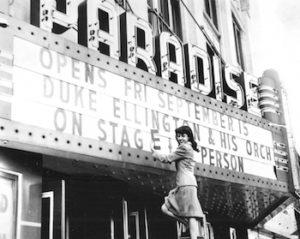
Paradise Theater
*The Black Bottom community is celebrated on this date in 1827. This was a predominantly Black neighborhood in Detroit, Michigan, United States.
"Black Bottom" often refers to the African American community that developed in the early twentieth century. Early white-French colonial settlers named the neighborhood. This area was the source of the River Savoyard, which was buried as a sewer in 1827. The river's flooding produced rich bottomland soils, which early French colonial settlers named the area "Black Bottom."
The area's leading commercial avenues were Hastings and St. Antoine Streets. An adjacent north-bordering area, known as Paradise Valley in the twentieth century, contained nightclubs where famous Blues, Big Band, and Jazz artists such as Billie Holiday, Sam Cooke, Ella Fitzgerald, Duke Ellington, Billy Eckstine, Pearl Bailey, and Count Basie regularly performed. In 1941, the city's Orchestra Hall was named Paradise Theatre.
Reverend C. L. Franklin, the father of singer Aretha Franklin, initially established his New Bethel Baptist Church on Hastings Street. Paradise Valley was home to the Gotham Hotel, which, at the time, was considered the best hotel for African Americans in the world. Before the Gotham Hotel, Black people often lacked access to quality hotels in cities. Black Bottom's business district thrived.
It served as a robust mini-city within Detroit, filled with Black doctors' offices, hospitals, drugstores, and other essential services. Before World War I, Hastings Street, which ran north-south through Black Bottom, was predominantly populated by European immigrants. Throughout the second half of the nineteenth century, these immigrants built the frame houses that black newcomers crowded into during the Great Migration and following World War II. This meant the homes were far from the pristine quality of the new constructions being erected for whites throughout Detroit's suburbs.
The term has sometimes been used to apply to the entire neighborhood, including Paradise Valley, but the two neighborhoods were considered separate. Brush Street bounded both Black Bottom and Paradise Valley to the west and the Grand Trunk railroad tracks to the east. They were bisected by Gratiot Avenue, the area known as Black Bottom reached south to the Detroit River. To the north, Grand Boulevard was defined as Paradise Valley.
Despite the rich cultural and musical hub of Black Bottom, the neighborhood was plagued by urban poverty. Most of Black Bottom's residents worked in manufacturing and automotive factories. Although some Black business owners and clergy members operating in the neighborhood were able to rise to the middle class, they quickly fled Black Bottom and Paradise Valley for the more attractive Detroit West Side neighborhoods. For the remainder of Black residents, lack of access to New Deal housing benefits and segregation by way of redlining ensured entrapment in Black Bottom's subpar housing conditions.
In the early 1960s, the Black Bottom and Paradise Valley neighborhoods were demolished for slum clearance and to make way for the construction of I-375. Although the city's urban planners promised new public housing projects to replace Black Bottom, these developments were never affordable or open to Detroit's Black residents. The once-thriving business district of Black Bottom was also bulldozed and ceased to exist. Black Bottom, as it used to be, exists now only as a symbol of resilience and tragedy. In the face of profoundly unjust housing practices and concentrated urban poverty, the neighborhood's Black residents created and maintained a lively and thriving community, which was later pushed out by city urbanization and highway construction. Though somewhat diverse, Conant Gardens, 8 miles north, wasn't affected.